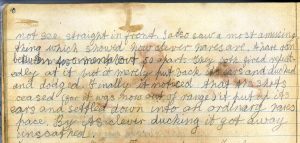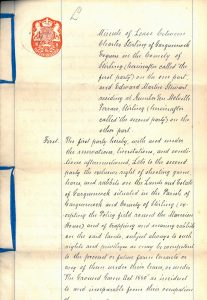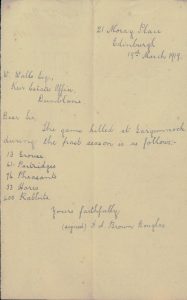When reading Viola’s latest entry, it is useful to remind ourselves that she is only twelve years of age. She writes about witnessing shooting of hares, although it is unknown if she was watching as part of the shooting group or secretively. Viola appears to take delight in watching the hare outwit and escape the two men trying to shoot it.
Brown hares are not native to Scotland and are thought to have been introduced by the Romans. Changes in farming have contributed to a decline in the brown hare population, although evidence in recent years may indicate a change.
Stirling Council Archives hold the estate records for Gargunnock (PD100). This includes details of the leasing of shooting rights. A lease drawn up in 1916 reveals that rental cost £70 for the season August to January. This provided exclusive rights to shoot game, hares and rabbits on the lands and estate (about 2000 acres). This included the use of Charles Stirling’s two sporting dogs, at a cost of 2 shillings per week per dog to the gardener who would feed and attend to the dogs. They were entitled to free use of the Ghillie occasionally. The lease also took account of the need to maintain wildlife populations. In order to preserve the hares it was stated that one field would be off limits for shooting.
Game bags for the season were reported and this one from 1918-1919 includes 33 hares. This is significantly less than the average in the previous decade which typically exceeded 100 hares.
Transcript
Nov 15. 1919. 3.30 pm.
I saw a hare run right up to a gun today I
was surprised for I had forgotten that they could
not see straight in front. I also saw a most amusing
thing which showed how clever hares are. A hare ran
between two men about 50 apart. They both fired repeat-
edly at it but it merely put back its ears and ducked
and dodged. Finally it noticed that the shots
ceased (for it was now out of range) it put up its
ears and settled down into an ordinary hare’s
pace. By its clever ducking it got away
unscathed.






